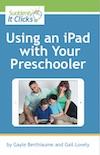Last time, we shared some ideas and apps for helping your little one practice the kinds of movements and "marks" that help them prepare for writing letters and numerals. (See our previous post about Getting Ready to Write.) This time, let's explore how children learn to write and some "best ideas" about how you and your tablet can help them do this well.
Learning to write takes more than a pencil and paper or tablet and finger. It takes coordination, some understanding of letters as parts of language, and motivation. Your children need to have enough motor control to trace lines and shapes with a little bit of accuracy. They need to have experienced letters enough to recognize them in their environment, including in books you read together, in signs in your neighborhood, or in packaging in your home or in the store. They do NOT have to know all the letter names or be able to recite the alphabet to begin learning to form letters. But learning the letter their own name starts with, common signs they see ("S-T-O-P spells STOP!"), and letters that they encounter as you read to them is helpful. If your child is not "letter aware," then learning to construct letters will be little different from tracing or drawing shapes.
Letter formation is about how legible the letters are, while letter construction refers to how the letters are formed. Letter construction matters. Letters in our alphabet are made in certain ways to help with the consistency and speed of letter formation and in some cases to ease the transition to other forms of writing such as cursive. Before you begin to teach your child to write letters, inquire at the school he is likely to attend and learn what style of lettering they prefer. This can be incredibly helpful to your child and the teachers, so he doesn't start school and have to unlearn the way he writes his letters. Then as you choose apps or methods, try to use the same letter construction techniques as the teachers — they will be very grateful.
Most educators, if asked, would like students who are beginning to write to learn to not just make the letters "look right" but also to have the WAY the letters are formed be correct. For example, in most handwriting systems or methodologies letters are formed beginning at the top of each letter, never at the bottom and letters with circular portions are almost always formed with a counterclockwise stroke. This is where the use of technology really shines!
As former early learning teachers we know that in the classroom it was difficult to monitor how young writers are constructing their letters. We were vastly outnumbered! Even as parents it is difficult help a young one understand that it matters how the "o" is made beyond it just being round. Enter the tablet. Letter writing apps are such a great tool on tablets because they will not allow a child to form a letter backward, upside-down or any other sort of "wrong." A good letter writing app will provide the kind of positive, accurate construction of letters that can lead to muscle memory and the automaticity of writing we hope for. Additionally, these apps encourage children to practice letters in ways that are much more engaging and interesting than the rows of crooked "G's" we remember writing.
As you look at apps for letter writing consider these things:
- Style of letter your child will use in school.
- Support for tracing as well as "free forming" letters as children are ready.
- Ability for you to add your own words (like your child's name, "Mom" or "Dad," or a sibling's name.
- How engaging and/or rewarding the style of the app will be for your child.
Once you choose an app, start small. Choose "letters of importance" like those in her name or the easy letters (l, o, t…) if you can. Be encouraging and celebrate her victories!

(iOS and Android)
Strengths: Great scaffolding of support from watching to tracing to freeforming with a wide variety of animations.

(iOS)
Strengths: Has letters and also words to practice. Ability to capture work via the built-in camera tool (saves to the camera roll). Easy to add words (with pictures and sound for non-readers).
Weakness: Not everyone likes the option to have children write words in all capital letters.

(iOS)
Strengths: Changing settings changes the language — English (UK and US), Spanish, German, French, Italian, and Bahasa Indonesian.
Weakness: Not easy to select specific letters; moves through alphabet in order.

(iOS)
Strengths: Can switch between letter sounds and letter names. Lots of child choices (colors, backgrounds, etc).
Weakness: A little too "busy" for some children (and many adults).

(iOS, Android, Kindle)
Strengths: Designed by Occupational Therapists with OT in mind. It provides a wide range of activities from simple lines to letters in little steps with lots of positives along the way.
Weakness: This app is a bit on the expensive side, as letter writing apps go, but it is a very complete package.

(iOS and Android)
Strengths: excellent parental controls for difficulty, etc., provides practice from early prewriting to writing. Accommodates multiple children and even provides parents with information on each child's progress.
Be sure to check out our book "?Using an iPad with Your Preschooler"? for even more apps and ideas!

Share your favorite prewriting activities or apps on the Scholastic Parents Facebook page, via email: Gail-Gayle@SuddenlyitClicks.com or tweet us at @suddenlyclicks.






